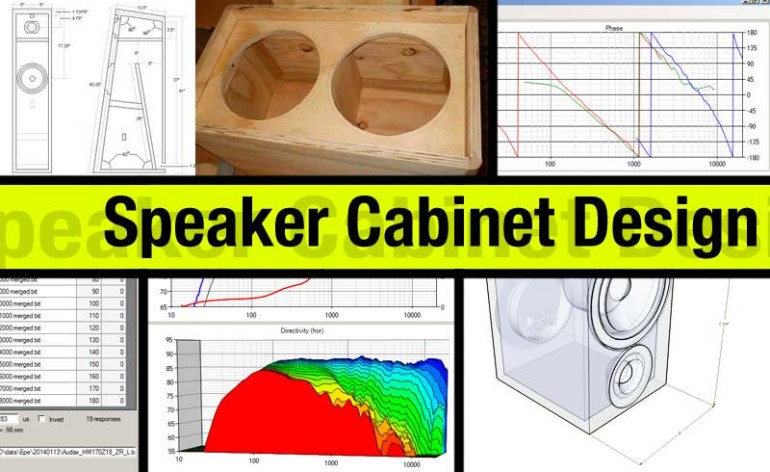Table Of Content

When test fitting drivers, it is a good idea to drill holes anduse hurricane nuts to allow secure mounting and remounting of drivers. It is also recommended to use biscuit jointswhen gluing panel walls together although it is acceptable to use screws tohold panel walls together for gluing. For this project, the baffle, bottom and backof the speaker were spray painted. Spraypainting MDF is time consuming because it requires several iterations ofsanding and painting to obtain a smooth finish since MDF absorbs some paint,especially on corners that are rounded over.
The Top Ten Most Influential Speakers of the Last 50 Years
This circuit wasdetermined based on using a 2nd order low-pass for the woofer,band-pass for the midrange and high-pass for the tweeter. Due to the response anomalies and differencesin sensitivity, additional elements were added. The first step in developing aloudspeaker is obviously deciding what the goals are. Do you want to build a 7 cubic foot behemothor 0.1 cubic foot desktop speaker for your office desktop?
Totally Addicted to Bass?!?
Sure, you can just bung some drivers in a box, but without someone like Peter Comeau pulling the strings, they won’t really sing... “At this point, you’ll expect to make design changes that ‘fine-tune’ the performance. When you’re satisfied with the pre-production unit and all the engineering wrinkles have been ironed out, you can hand over the drawings to mass production." It can be a rough and unfinished wooden box, complete with staples and splinters. This is the stage where the most research wil take place, along with the most changes. Audio specifications run the gamut from merely “nice to know” to “genuinely useful.” A speaker’s impedance rating should be one of those genuinely useful specs, but you can’t always trust them.
Start listening
Together, these cover different frequencies and create balanced sound with accurate tones. To better understand hi-fi speakers, delve into the world of hi-fi speakers and explore the sub-sections of “What is Hi-Fi? ” and “Importance of Speaker Design in Hi-Fi Systems.” Discover the principles and significance of speaker design within the realm of hi-fi audio, elevating your listening experience to new heights. You really start to save money when building a 3-way speaker system. If you are an experienced builder withthe right testing equipment using high end components, then a 2-way system might be right for you. The assumption many people make is that a singlesubwoofer can be placed anywhere in the room because low bass is omnidirectional.
What is the Difference Between Digital and Analog Audio?

The ESL-57 doesn’t have much low bass, won’t play very loudly, and produces a very narrow sweet spot, but when operated within its limitations, it’s magical. To ensure optimal performance of hi-fi speakers, testing and evaluating them is essential. Frequency response testing, distortion testing, and listening tests are the key sub-sections involved in this process. Each sub-section allows for a comprehensive assessment of speaker performance, addressing specific aspects such as frequency range, distortion levels, and subjective sound quality.
Part of the confusion around this speaker type (among other leaps of intellect) revolves around naming conventions. So-called planar-magnetic speakers are variations on the magnetostatic drive concept. To make things worse, Yamaha also promoted the term “Orthodynamic” in the headphone world as a way to brand their planar-magnetic headphone technology. The above diagram shows a passive LPF in series with the woofer, and a passive HPF in series with the tweeter.
Timing and rhythm also have to be transmitted to the listener with precision. He was co-founder and technical director of British loudspeaker manufacturer Heybrook, prior to joining Mission as director of acoustic design in 1999. So when a designer is tasked with making a small speaker that produces very deep bass, they can do that, but that small speaker won't play as loud as a similar design that forfeits some deep bass power.
Ribbon loudspeakers are characterized by a remarkable ability to produce extremely clean and quick transients—such as those of plucked acoustic guitar strings or percussion instruments. The sound seems to start and stop suddenly, just as one hears from live instruments. Ribbons sound vivid and immediate without being etched or excessively bright. In addition, the sound has an openness, clarity, and transparency often unmatched by dynamic drivers. (Incidentally, these qualities are shared by ribbon microphones.) Finally, the ribbon’s dipolar nature produces a huge sense of space, air, and soundstage depth (provided this spatial information was captured in the recording).
Tweeters
A solution to this physics problem is the electromagnetic driver (also called a field-coil driver) in which the driver’s fixed magnets are replaced with a large coil that functions as an electromagnet. The coil is driven with direct current from an outboard power supply that plugs into an AC outlet. This current flow through the coil creates the magnetic field against which the voice-coil–generated magnetic field pushes and pulls. The electro-magnet produces a magnetic field strength in the gap (the area in which the voice coil sits) nearly double that of a conventionally driven woofer. Consequently, the electromagnetic woofer can be heavier (giving it a lower resonant frequency) yet simultaneously more efficient. Moreover, the woofer’s bass output can be adjusted by varying the current through the electromagnetic coil.
Because it is current flow through the voice coil that causes the cone to move back and forth, increased voice-coil resistance reduces the amount of sound produced by the driver. In other words, you can keep turning up the volume, but the speaker reaches a point where it won’t play any louder. Tweeters work on the same principle, but typically use a 1″ dome instead of a cone. Common dome materials include plastic, woven fiber coated with a rubbery material, titanium, aluminum and aluminum alloys, and gold-plated aluminum. A recent trend has been toward making tweeter diaphragms from materials such as beryllium and even diamond.
Revamping the Symphony with the LV Nanogram Speaker: Louis Vuitton's Latest Innovation in Sound - RAIN Magazine
Revamping the Symphony with the LV Nanogram Speaker: Louis Vuitton's Latest Innovation in Sound.
Posted: Thu, 25 Jan 2024 08:00:00 GMT [source]
The aim here was to make a crossover that balanced woofer and tweeter, and had a smooth transition from woofer to tweeter without any massive peaks or troughs, which has been achieved. The Displacement Calculator is a best guess to the displacement of the speaker driver. It is not exact, but the more information you provide the better it will be.We will use 103mm as the cone diameter - not the 130mm diameter of the outer metal edge of the driver.Mounting depth is 45.5mm and magnet diameter is 90mm. Magnet height is not provided, so we measured a value of 30mm assuming this drawing is to scale.If we had the drivers in hand, then we could measure them to be sure. We also need to indicate that we will be flush mounting the driver and using 3/4" thick lumber in our enclosure.
21 Best Bluetooth Speakers (2024): Portable, Waterproof, and More - WIRED
21 Best Bluetooth Speakers ( : Portable, Waterproof, and More.
Posted: Sun, 18 Feb 2024 08:00:00 GMT [source]
The membrane is charged to a very high voltage with respect to the stators. The audio signal is applied to the stators, which create electrostatic fields around them that vary in response to the audio signal. The varying electrostatic fields generated around the stators interact with the membrane’s fixed electrostatic field, pushing and pulling the membrane to produce sound. This illustration also shows a dynamic woofer as part of a hybrid dynamic/electrostatic system. Problems with Dynamic DriversOf all the components in your system, the loudspeaker is the most likely to develop trouble. The most common problem is a blown driver, usually the tweeter—it simply stops working.
Ultimately,designing your own loudspeaker is something you do because you like thecreative side of designing things. Ifyou are after bang for your buck sound, it is much cheaper and less time consumingto use someone else’s well-established and well-documented DIY design withpre-fabricated cabinets. A no-compromise approach that considers every detail, delivering the ultimate in performance. Crafted by one designer to convey the recording not to reinterpret it, there is consistent musicality right across the Harbeth loudspeaker range. This field puts a “push-pull” force on the diaphragm and in turn the moves air on either side.
High power speakers are designed to have a high excursion (thats lots of cone movement) – in order to be able to handle the extra power, they typically have stiffer components, particularly with regard to the suspension. These high power speakers require a certain amount of power to overcome the mechanical resistances of the suspension. Comparing two extreme examples, of say a 100W speaker and a 1000W speaker running bass. Lets suppose you only have a 100W amplifier, the 100W speaker will give you more output than the 1000W speaker. As you keep ramping up the power, the 1000W woofer will ultimately create a lot more sound output than the 100W speaker ever will, but if you only have a small amplifier, you are better off with an appropriately matched driver. So the response has a few bumps, but we have a working design, which is potentially good enough for some applications.
The measurement data is subsequently used in SoundEasy’s crossoverdesign tool. This design has the distinct advantage of reducing sonic distortion by an order of magnitude compared to basic dynamic cone drivers. Because they’re so light, they also exhibit exceptional frequency response. However, the restricted movement of the membrane limits the amount of air volume that can be pushed, a shortcoming that manifests in the form of poor bass reproduction. Playing close consideration to where electrostatic loudspeakers are placed in a room is also critical, since the physics of sound reflection has a major impact on their sound quality. This tweeter wasselected because it is also well reviewed, has good power handlingspecifications, is relatively linear and has a low enough resonantfrequency.

No comments:
Post a Comment